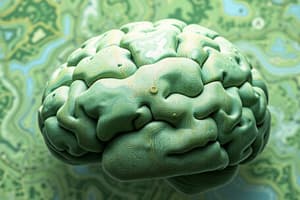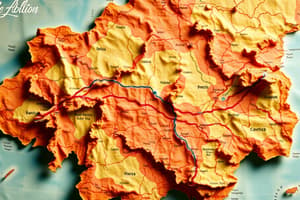Podcast
Questions and Answers
What do cognitive maps refer to?
What do cognitive maps refer to?
- Mental representations of our environment (correct)
- Physical maps of cities and buildings
- Visual perceptions of surroundings
- Auditory experiences in different environments
Who first introduced the concept of cognitive mapping?
Who first introduced the concept of cognitive mapping?
- Sigmund Freud
- Richard E. Tolman
- Ivan Pavlov
- James J. Gibson (correct)
According to Tolman, what did rats construct to navigate their environments?
According to Tolman, what did rats construct to navigate their environments?
- Visual illusions
- Abstract paintings
- Visual media
- Spatial representations (correct)
How did Gibson view perception?
How did Gibson view perception?
What is one of the roles of cognitive maps in navigation?
What is one of the roles of cognitive maps in navigation?
In which field was Tolman's theory of cognitive maps further developed?
In which field was Tolman's theory of cognitive maps further developed?
What is the primary purpose of cognitive maps, according to the text?
What is the primary purpose of cognitive maps, according to the text?
How can cognitive maps aid in planning, as mentioned in the text?
How can cognitive maps aid in planning, as mentioned in the text?
Which technique is NOT mentioned in the text as a way to study cognitive maps in behavioral neuroscience?
Which technique is NOT mentioned in the text as a way to study cognitive maps in behavioral neuroscience?
How can cognitive maps help individuals predict outcomes?
How can cognitive maps help individuals predict outcomes?
What is the role of cognitive maps in urban planning, as mentioned in the text?
What is the role of cognitive maps in urban planning, as mentioned in the text?
Which of the following statements is NOT true about cognitive maps, according to the text?
Which of the following statements is NOT true about cognitive maps, according to the text?
Flashcards are hidden until you start studying
Study Notes
Cognitive Maps
Cognitive maps refer to mental representations of our environment that help us navigate through it efficiently. These maps can include physical spaces like cities, buildings, and rooms, as well as abstract concepts such as social hierarchies and professional networks. They are crucial for both spatial and non-spatial navigation because they allow us to efficiently plan routes, predict outcomes, and understand relationships between different parts of our environments. In this article, we will discuss the origins of cognitive maps, how they function, their role in behavioral neuroscience, and the influence of cognitive maps on urban planning.
Origins of Cognitive Maps
The concept of cognitive mapping was first introduced by environmental psychologist James J. Gibson in his book "The Ecological Approach to Visual Perception," published in 1979. Gibson argued that perception is not passive, but active and adaptive, with humans constantly updating their understanding of their surroundings based on new information gathered from their senses. This view was expanded upon by Richard E. Tolman's theory of cognitive maps, which was further developed into the field of environmental psychology.
Tolman believed that rats could construct internal, spatial representations of their environments, allowing them to learn and remember the locations of food sources even when there were obstacles blocking their direct line of sight. He referred to these representations as "cognitive maps" and demonstrated that rats can integrate multiple pieces of information to form coherent maps of their environments. This concept has since been applied to human cognition, with researchers using techniques derived from Tolman's work to study how people create and utilize cognitive maps in various contexts.
Functioning of Cognitive Maps
Cognitive maps serve several purposes, including:
-
Spatial Navigation: By maintaining a mental representation of their environment, individuals can navigate through their surroundings more efficiently. For example, if you know where your local grocery store is located, you can quickly travel to it without getting lost, even if there are obstacles in your way.
-
Planning: Cognitive maps allow individuals to plan their routes before embarking on a journey. For instance, if you are going to a new city, you can study a map of the city to learn about its layout and plan your route to your destination.
-
Predicting Outcomes: Cognitive maps help individuals predict the outcomes of their actions. For example, if you know that your favorite restaurant is located near a busy intersection, you might choose to visit it during non-peak hours to avoid traffic.
-
Understanding Relationships: Cognitive maps also help individuals understand the relationships between different elements of their environment. For example, if you have a cognitive map of your city, you can understand how different neighborhoods are connected and how they relate to each other.
Role in Behavioral Neuroscience
In behavioral neuroscience, cognitive maps are studied to understand how humans and animals perceive and interact with their environments. Researchers use a variety of techniques, including:
-
Behavioral Tasks: Experiments involving rats navigating through mazes or city simulations allow researchers to study the formation and use of cognitive maps in spatial navigation.
-
Neuroimaging Techniques: Techniques such as functional magnetic resonance imaging (fMRI) and electroencephalography (EEG) can be used to study the neural activity associated with cognitive mapping.
-
Neuropsychological Assessments: Comparing the cognitive mapping abilities of individuals with brain injuries or neurodegenerative diseases can provide insights into the neural mechanisms underlying cognitive mapping.
Influence on Urban Planning
Cognitive maps also play a crucial role in urban planning, helping city planners create environments that are efficient and easy to navigate. For example, well-designed public transportation systems can help individuals efficiently navigate through a city by providing them with a cognitive map of the city's layout. Additionally, the design of buildings and public spaces can be optimized to create cognitive maps that facilitate efficient navigation and improve the overall quality of life for city residents.
In conclusion, cognitive maps are powerful mental representations that help us navigate through our environments, plan routes, predict outcomes, and understand relationships between different elements of our surroundings. They have been studied in various fields, from environmental psychology to behavioral neuroscience, and have a significant impact on urban planning. As we continue to learn more about the formation and functioning of cognitive maps, we can use this knowledge to create more efficient, user-friendly environments that cater to our cognitive abilities.
Studying That Suits You
Use AI to generate personalized quizzes and flashcards to suit your learning preferences.




